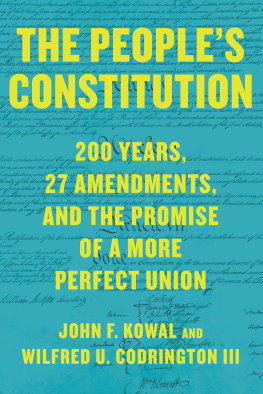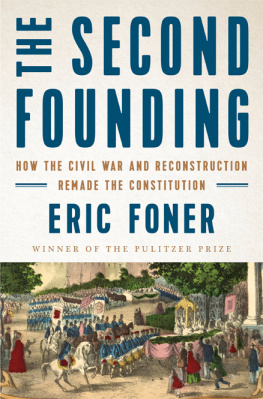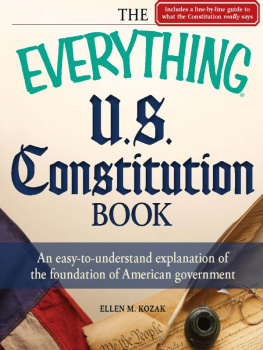Contents
Page List
Guide
THE PEOPLES CONSTITUTION
THE PEOPLES CONSTITUTION
200 Years, 27 Amendments, and the Promise of a More Perfect Union
John F. Kowal
and
Wilfred U. Codrington III
Contents
Notes to the Reader
First, a few notes on sources. This book has benefited greatly from the work of historians and legal scholars who blazed the trail before us. At the same time, we also rely heavily on original primary sources. In some instances, particularly in the early periods covered by this book, there is little or no primary source record. We try to indicate in the text where this is the case including, most notably, in early congressional records.
A special note is warranted concerning the records from the 1787 Philadelphia Convention, which produced the Constitutions original draft. While several delegates took notes, the most complete record by far is found in James Madisons Notes of Debates in the Federal Convention of 1787. Countless scholars have relied on his daily recordkeeping, which provides the best account of the delegates speeches, debates, votes, and the proceedings in general. As the last surviving delegate from the convention, Madison revised his notes extensively prior to their publication in 1836, four years after his death. Some of those revisions appear to correspond with how he desired to be viewed by his contemporaries and in posterity, including his positions on controversial issues related to federalism and slavery. The reader should therefore be aware that his extraordinary record of the convention may not fully reflect his or others contemporaneous thinking.
Relatedly, some historical sourcesincluding Madisons notesadhere to outmoded and non-uniform writing conventions. For example, they contain arcane words, inconsistent spelling, and the awkward use of capitalization, punctuation, abbreviations, and other grammatical departures. For the sake of clarity, we have taken the privilege of making small adjustments to modernize the prose while remaining loyal to the intent of the original authors.
Second, a note about our own conventions. Throughout the book, we have capitalized Framer when referring to those who drafted the original Constitution, but not those who were responsible for the various amendments that followed. This is not intended to diminish the successive generations of framers or to devalue the importance of their work that has improved our national charter. Rather, it is to make clear for the reader when we are referring to that first cohort versus the ones that followed. Also, we have decided to capitalize the word Black when describing persons of African ancestry. This is our small attempt to acknowledge both the dignity and respect due to those to whom dignity and respect were long denied. Some sources have recently begun to make changes to their own editorial style guides in adherence with this convention. We applaud this choice, and hope that others will emulate it.
Finally, this book uses the words Black and African American interchangeably with one caveat: we have opted to use the former exclusively in our account prior to the Reconstruction Era. This decision was made in acknowledgment of the fact that our early laws, institutions, and customs all too frequently withheld fundamental citizenship rights from this group. While the injustice persisted even after the Reconstruction Era, the significance of that periods amendmentsparticularly the Fourteenth Amendmentcannot be overstated for their long-overdue recognition of their citizenship and enshrining their rights permanently into our national charter. Similarly, we refer to those who resided on this continent prior to European settlement as Indigenous people, understanding (though not fully) the complexity of their relationship with the U.S. government that continues to this day. Chapter Three opens with a riff on the famous line in William Shakespeares Romeo and Juliet: Whats in a name? In truth, the answer is a lot. Names, words, titles, and other identifiers are important; they can reflect pain and struggle, purpose and power, and so much more. To these subordinated groups and others who, like the Bards rose, would by any other name smell as sweet, we hope our that word choices will convey the respect that you deserve.
THE PEOPLES CONSTITUTION
Introduction
Who wrote the United States Constitution?
The answer seems easy enough. One can visit the National Archives in Washington, DC, where the original parchment pages of Americas national charter are preserved for posterity in argon gasfilled encasements of titanium and glass.
These Framers traveled to Philadelphia to shore up a weak and dysfunctional political system established under the Articles of Confederation, Americas first attempt at a national charter. Their mandate: establishing in these states a firm national government. Over four months, from the flowering of the chestnut trees in May to the first turning of the sugar maples in September, the debates at the Philadelphia Convention ranged from the finer points of comparative law and Enlightenment theory to the days most divisive issues: taxation, voting, commerce, slavery. At every step, clashing interests pitted the large states against the small, the North against the South. Some delegates walked away from the deliberations in dismay, others for personal reasons. But those who remained, working in a room sealed shut to protect against eavesdroppers, forged a bold new plan of government. It was, fundamentally, a document based on compromise. Compromises between champions of a strong centralized government and those committed to robust state sovereignty. Compromises between defenders of slavery and those who professed to abhor it. Compromises between idealists who imagined a government elected by the people and skeptical elitists eager to counter the excesses of democracy.
The Constitution they crafted was a remarkable achievement for its time. By providing the national government with powers it lacked under the Articles of Confederation, the Framers made sure the American people could act collectively to address pressing national problems. In a notable innovation, they divided these powers among three branches of governmentlegislative, executive, and judicialwith distinct roles and overlapping responsibilities. This carefully calibrated structure, based on the principle of separation of powers, was designed to prevent dangerous concentrations of power through the proper checks and balances between the different departments.
Its the worlds most enduring written national constitution. But though Americans in every generation have mythologized the story of the Philadelphia ConventionThomas Jefferson memorably called it an assembly of demigodsthe drafters of the Constitution were fallible men, steeped in the values and worldview of a time long past. Though they subscribed to the creed that all men are created equal, nearly half of them owned slaves. Most took it as a given that only men of property, like themselves, could possess the civic virtue necessary for self-governance. None could imagine a world in which women were truly equal, with rights independent of their husbands and fathers. So it should come as no surprise that the plan they crafted had its shortcomings.
For starters, the Framers plan of government was antidemocratic in key respects, designed to shield politicians from popular pressure. They delegated the power to choose our presidents to a small group of intermediaries we know as the Electoral College. In similar fashion, they left it to state legislatures to choose senators. In the Framers republic, only members of the House of Representatives would be chosen by the people themselves. But which people? In their wisdom, the Framers failed to recognize a right to vote, leaving it to each state to determine voter qualifications. Through our entire history, even









